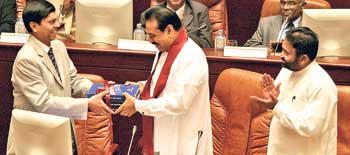
Growing in debt: Are we heading to a debt trap?
The national debt being higher than GDP is no April Fools’ joke. The mounting public debt is a national concern for the future as well as the present. At Rs. 2537.5 Billion at the end of November last year, the debt is likely to be higher than the 2006 GDP. The public debt has grown by 16 percent in the twelve months since November 2005, when it was Rs. 2183.8 billion. With this increase during 2006, it is likely that at year’s end the national debt would be higher than the 2006 GDP that is expected to grow by around 7 percent. The economy is growing in debt. The rate of growth of the country’s debt is higher than the growth in the economy, especially the real growth in goods and services rather the salaries and payments to public officers that keeps increasing each year. At the end of November 2006 public debt was larger than the national income of 2005. It was 107 percent of the 2005 GDP. Since the debt would be higher at the end of 2006 and the optimistic forecast of GDP growth is 7 percent, the public debt at the end of 2006 would be once again higher than the GDP.
The comparison with GDP is to indicate the severity of the debt burden. What is most significant is debt servicing burden of the debt. Debt service payments constitute a serious burden on the budget. The seriousness of the problem can be seen from a few indicators. In 2005 debt service payments absorbed 96.5 percent of government revenue. In other words almost the entirety of government revenue went for servicing the debt. What this means is that the government does not have money for other expenditure that is vital for the economy. In addition to this when perhaps as much as 8 percent of GDP is spent on the war, developmental and social needs are starved of finance. There are also committed expenditures in the social sector such as wages and salaries of teachers and medical personnel and essential servicing costs of government that have to be met. Consequently the government runs a large budget deficit of around 9 percent of GDP that is highly inflationary. The high debt servicing costs result in further borrowing and consequently the debt increases and the debt servicing costs increase. This results in a cyclic problem where the high public debt and its servicing costs lead to further borrowing and further indebtedness and increasing debt burden. The public debt therefore tends to grow exponentially when the government borrows afresh to meet both the debt servicing costs and the current and capital expenditure. This is why the public debt has been ballooning. The public debt consists of domestic debt and foreign debt. The domestic debt is the higher component. In 2005 it was 56.9 per cent of the total debt. The foreign debt constituted 43.1 percent of the total debt. The good thing about the domestic debt component is that the servicing cost is a payment to nationals and national institutions and there is a circulatory flow of incomes within the country. The foreign debt at the end of November 2006 was Rs.1082.4 compared to Rs 926.8 million twelve months before. Therefore the foreign debt has grown by nearly 17 percent in the 12 months. The servicing of the foreign debt is a burden on the public finances and the balance of payments. At the end of 2005 the foreign debt servicing cost had more than doubled from what it was in 2004. This means that a larger proportion of the export incomes would have to pay for debt servicing, leaving less earned funds for imports. Conversely export earnings would have to rise sharply. In 2005 about 3.6 percent of export earnings were used for repayment of loans (amortisation) and interest costs. It is estimated that the proportion of export earnings that are needed for serving foreign debt in 2006 would be 7.9 percent of export earnings. This doubling of the foreign debt servicing cost is again a strain on the balance of payments. However the proportion of export earnings that is required to finance debt servicing is quite modest and bearable. It should not be allowed to escalate as high foreign debt servicing costs create strains on the balance of payments. The lurking dangers of an increasing public debt on economic policy and economic growth in Sri Lanka has been aptly summarised by the Asian Development Bank (ADB). “Excessive accumulation of public debt can adversely affect the financial markets and the Government’s development efforts. In particular, interest payments on a large stock of public debt could constrain fiscal expenditure and prevent the Government from focusing on investments in physical and social infrastructure. Moreover, a rising interest burden can easily allow public debt to spiral out of control. These concerns will, in turn, impair the autonomous management of the monetary policy by driving the monetary authority to increase inflation and lower interest rates. More fundamentally, room for managing aggregate demand to mitigate economic fluctuation, a key role of the monetary and fiscal policies, is very limited in Sri Lanka.” This was stated with respect to the debt situation a few years ago when the problem was somewhat less. They advised the authorities in these words. “The Government and the Central Bank have to strengthen their coordination in macroeconomic policy to reduce public debt as well as fiscal deficit.” In spite of this the Central Bank continues to accommodate and justify the reckless fiscal extravaganza rather than coaxing it to fiscal discipline. |
|| Front
Page | News | Editorial | Columns | Sports | Plus | Financial
Times | International | Mirror | TV
Times | Funday
Times || |
| |
Copyright
2007 Wijeya
Newspapers Ltd.Colombo. Sri Lanka. |
